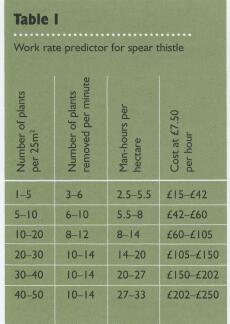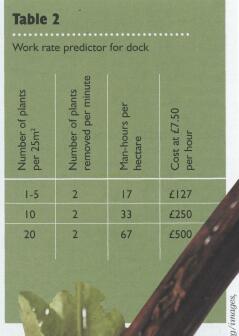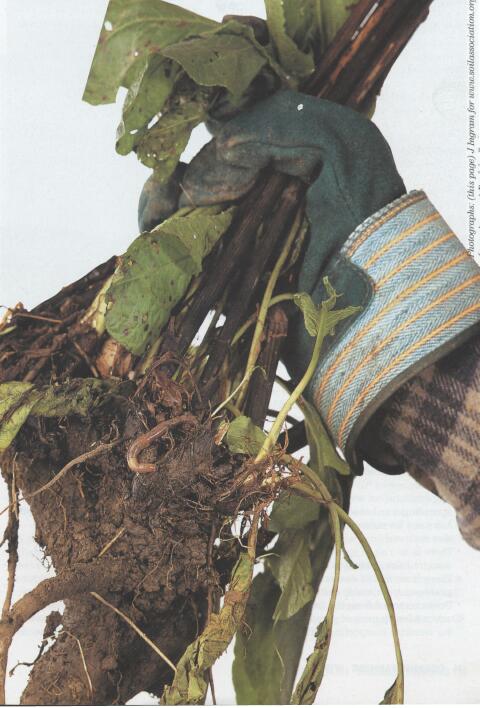The
Root of the Problem
Dr. John Zarb
Article from Organic Farming (Cover Story) Winter 2004 Issue 84
Return
to Publications Page | Page 1
| Page 2 | Page
3 | Page 4 |
Individual plant removal
Handwork with
modern, well-designed
tools has a number of key benefits. Weeds
can be tackled at any convenient time,
sometimes in one pass - for example, a
team removed all dock, ragwort, and spear
thistle from a Countryside Stewardship
wild flower meadow at a cost of just over
£40/ha (£17/ac). The ergonomic efficiency
of the tools enables a worker to operate
without undue fatigue. Some 90 per cent of
weeding can be done in late autumn, winter
and spring, when the grass is shorter and
the ground softer, before the growing
season. There is no need to let plants like
ragwort grow tall enough to weed-wipe
or grasp as with other hand tools. It is
possible to remove plants as rosettes.
It is also easy to see what has been
dealt with and what still needs to be
tackled, which is not always the case with
chemicals. There is no need to exclude
stock and there are none of the weather,
safety training, protection or disposal
considerations that apply to chemicals.
The material can also be collected for
composting.
tools has a number of key benefits. Weeds
can be tackled at any convenient time,
sometimes in one pass - for example, a
team removed all dock, ragwort, and spear
thistle from a Countryside Stewardship
wild flower meadow at a cost of just over
£40/ha (£17/ac). The ergonomic efficiency
of the tools enables a worker to operate
without undue fatigue. Some 90 per cent of
weeding can be done in late autumn, winter
and spring, when the grass is shorter and
the ground softer, before the growing
season. There is no need to let plants like
ragwort grow tall enough to weed-wipe
or grasp as with other hand tools. It is
possible to remove plants as rosettes.
It is also easy to see what has been
dealt with and what still needs to be
tackled, which is not always the case with
chemicals. There is no need to exclude
stock and there are none of the weather,
safety training, protection or disposal
considerations that apply to chemicals.
The material can also be collected for
composting.
Integrated weed management
Effective weed
control requires
forethought, and should be integrated
with other techniques. Along with the
physical removal of weeds, farmers
must also consider a range of other tactics
as part of a long-term weed
control strategy, such as:
forethought, and should be integrated
with other techniques. Along with the
physical removal of weeds, farmers
must also consider a range of other tactics
as part of a long-term weed
control strategy, such as:
• Efficient
grazing management to
optimise pasture use. In particular,
avoid unrestricted winter grazing since
poaching encourages the growth of
prevalent weeds
optimise pasture use. In particular,
avoid unrestricted winter grazing since
poaching encourages the growth of
prevalent weeds
• Avoiding the
vegetative spread of weeds
like creeping thistle, couch and dock
that re-grow from root fragments after
ploughing or rotovating
like creeping thistle, couch and dock
that re-grow from root fragments after
ploughing or rotovating
• 'Hot composting'
- ensuring that the
compost pile reaches temperatures j
of between 60C-65C before turning
to reactivate the process to destroy
weed seeds effectively
compost pile reaches temperatures j
of between 60C-65C before turning
to reactivate the process to destroy
weed seeds effectively
• Removing plants
before seed
set - an obvious but neglected
practice
set - an obvious but neglected
practice
• Choosing drilling
times and
seed rates to enable rapid
early and full crop cover
in order to achieve
weed suppression
- that is if the birds
do not eat the seeds first!
seed rates to enable rapid
early and full crop cover
in order to achieve
weed suppression
- that is if the birds
do not eat the seeds first!
Avoiding the
I
spread of weed
seeds in hay and
silage
spread of weed
seeds in hay and
silage
• Encouraging
weed control onneighbouring land


